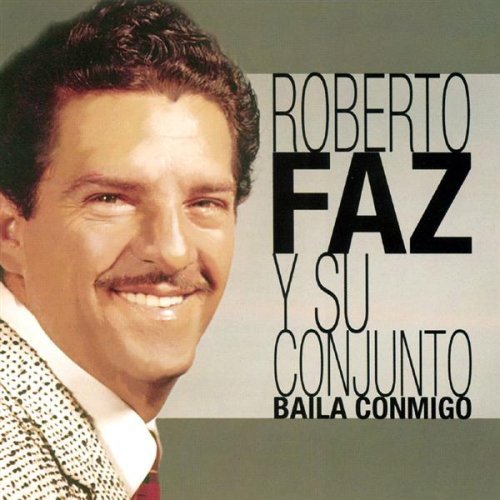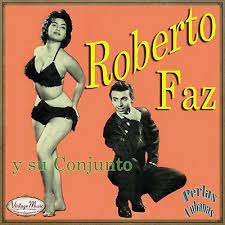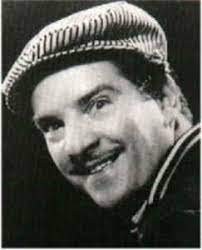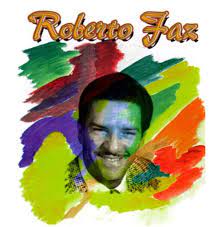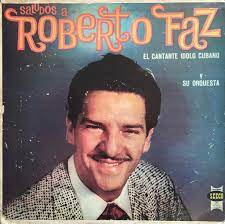ROBERTO FAZ, POPULAR CUBAN MUSICIAN, SINGER, AND BANDLEADER. VIDEOS
Roberto Faz Monzón born on September 18, 1914, in the town of Regla was a Cuban singer who reached the height of his popularity during the 1950s and early 1960s. Like his contemporary Benny Moré, he specialized in many forms of Cuban music such as son, guaracha, and bolero.
His parents were Pascual Faz and Angelita Monzón. He belonged to a poor family of three brothers and Roberto had to battle hard to become a singer of popular music renowned in Cuba and abroad. At 13 years old (1927) integrated the Champagne Set Sport and later the Tropical and Ricardo Cabanas executed maracas, guiro, tom, and bass. It was the time when tresero-oriented musicians and trumpet Juan Suarez and the famous Felix would Chapottin with which obtained the secrets of Cuban son.
https://youtu.be/WJiCqbWnujc
ROBERTO FAZ (VIDEOS)
ARTISTIC CAREER
In 1930 Roberto Faz was part of Septeto overseas organized by his father and two years later (1932) and was the lead singer of the Copacabana Orchestra, Continental, and soon after the Havana Group. In 1935 at the famous cabaret Sans-Souci acts with the famous Orquesta Hermanos Palau where the style of Roberto Faz begins to be noticeable. Since 1936 not only sings but also is an excellent performer of percussions like bongos, congas and Creole pailitas cosmopolitan in orchestras performing in programs CMQ Radio Cadena Habana and the Band of Brothers Lebatard.
In 1941, singer and percussionist in the Hotel Nacional with the orchestra of Osvaldo Estivill in the company of singer Tito Gómez and three years later is the famous singer set Kubavana official with whom he performed at the cabaret Zombie Club and made his first commercial recordings guaracha like “I do not care about you” by Mario Recio, and the bolero “Why are you leaving so soon?” Hugo Cruz, among others. But its true consecration accomplished in 1944 when called by the singer and director Roberto Espí for the singer in his Conjunto Casino, which eventually became his most significant and popular vocalist. With this grouping, Roberto Faz made his first tours abroad, Puerto Rico, Venezuela (1945-1946), and soon to Tampa, Key West, Panama, and Mexico, which is well known for his recordings for RCA Victor and from Panart 1948 for Cuba.
Since 1950 Roberto Faz and Conjunto Casino with its mythological trio of voices Espí Roberto, Roberto Faz, and Agustin Ribot, and later by Reyes Rolito and achieve great successes in Latin America. The strong voice, clear and sharp, full of musicality Faz, was to become one of the most famous in the son, guaracha and most especially in the bolero. They remind many famous titles with the Casino as “Reality and Fantasy” by Cesar Portillo de la Luz, “Love and see” by J. A. Mendez, and guaracha “smudging ball” by A. Ruíz. In the early years of the fifties, Casino operates with major Cuban television programs.
FOUND HIS OWN MUSICAL ENSEMBLE
In 1956 he founded his popular Roberto Faz Group with some musicians and singers from the Casino group and Loelangel Rodriguez, Orlando Reyes making his debut in the halls of Liceo de Regla, his hometown. And after working in the Sevilla Biltmore Hotel, Casino Deportivo, the Stadium, and the famous cabaret Tropical Ali Bar Club, with Fernando Alvarez and duetting with the great Benny Moré.
In 1957 he made his first LP with his group for an invoice Panart disk recording and musically excellent. Faz’s voice and overall have a great success especially with the bolero “Understanding”, in C. Doval and sones “Living in Luyanó” by R. Barrera and “stuff that has my Cuba” of P. Salazar. In 1966 Faz and reach the whole climate of popular acceptance in the style of recording sets pace sones called dengue. Works such as “Dengue cana”, Montero and Castillo and Face own, “Dengue in F” with a stomping beat.
The sonero Roberto Faz with his presence was always brewing optimism and joy. Underpinned all his musicality proven their pitch, rhythm, and vocal range, as well as its rich improvisation and sones montunos guarachas. The excellent voice of Roberto Faz is registered in about four recordings, all are nourished from the thirties, which is an example of Cuban popular music today.
Roberto Faz died on April 26, 1966, in Havana, he was 51 years old.
ROBERTO FAZ, POPULAR MÚSICO CUBANO, CANTANTE Y DIRECTOR DE ORQUESTA. VIDEOS
Roberto Faz Monzón, nacido el 18 de septiembre de 1914 en la localidad de Regla, fue un cantante cubano que alcanzó la cúspide de su popularidad durante los años cincuenta y principios de los sesenta. Al igual que su contemporáneo Benny Moré, se especializó en muchas formas de la música cubana como el son, la guaracha y el bolero.
Sus padres fueron Pascual Faz y Angelita Monzón. Pertenecía a una familia pobre de tres hermanos y Roberto tuvo que luchar duro para convertirse en un cantante de música popular reconocido en Cuba y en el extranjero. A los 13 años (1927) integró el Champagne Set Sport y posteriormente el Tropical y Ricardo Cabanas ejecutaron maracas, güiro, tom y bajo. Era la época en que los músicos de orientación tresero y trompeta Juan Suárez y el famoso Félix iban a Chapottin con el que obtenían los secretos del son cubano.
https://youtu.be/264dTy-aBuY
ROBERTO FAZ (VIDEOS)
CARRERA ARTÍSTICA
En 1930 Roberto Faz formó parte del Septeto Overseas organizado por su padre y dos años después (1932) y fue el cantante principal de la Orquesta de Copacabana, Continental, y poco después del Grupo de La Habana. En 1935 en el famoso cabaret Sans-Souci actúa con la famosa Orquesta Hermanos Palau donde comienza a notarse el estilo de Roberto Faz. Desde 1936 no solo canta sino que también es un excelente intérprete de percusiones cosmopolitas como bongos, congas y pailitas criollas en las orquestas actuando en los programas CMQ Radio Cadena Habana y la Banda de los Hermanos Lebatard.
En 1941, cantante y percusionista en el Hotel Nacional con la orquesta de Osvaldo Estivill en compañía del cantor Tito Gómez y tres años después es oficial el célebre cantor Kubavana con quien actuó en el cabaret Zombie Club y realizó sus primeras grabaciones comerciales de guaracha. como “No me importas” de Mario Recio, y el bolero “¿Por qué te vas tan pronto?” Hugo Cruz, entre otros. Pero su verdadera consagración se cumplió en 1944 cuando el cantante y director Roberto Espí lo convocó para el cantor en su Conjunto Casino, que eventualmente se convirtió en su vocalista más significativo y popular. Con esta agrupación, Roberto Faz realizó sus primeras giras al exterior, Puerto Rico, Venezuela (1945-1946), y próximamente a Tampa, Cayo Hueso, Panamá y México, que es muy conocido por sus grabaciones para RCA Victor y de Panart 1948 para Cuba.
Desde 1950 Roberto Faz y Conjunto Casino con su mitológico trío de voces Espí Roberto, Roberto Faz y Agustín Ribot, y más tarde por Reyes Rolito y logran grandes éxitos en América Latina. La voz fuerte, clara y aguda, llena de musicalidad de Faz, iba a convertirse en una de las más famosas en el son, la guaracha y muy especialmente en el bolero. Recuerdan muchos títulos célebres con el Casino como “Realidad y Fantasía” de César Portillo de la Luz, “Amar y ver” de J. A. Méndez, y guaracha “Bola mancha” de A. Ruíz. En los primeros años de la década de los cincuenta, Casino opera con importantes programas de televisión cubanos.
https://youtu.be/uettR0ZIeq8
ROBERTO FAZ (VIDEOS)
FUNDA SU PROPIO CONJUNTO MUSICAL
En 1956 funda su popular Grupo Roberto Faz con algunos músicos y cantantes del grupo Casino y Loelangel Rodríguez, debutando Orlando Reyes en los salones del Liceo de Regla, su ciudad natal. Y después de trabajar en el Hotel Sevilla Biltmore, el Casino Deportivo, el Estadio y el famoso cabaret Tropical Ali Bar Club, con Fernando Alvarez y a dúo con el gran Benny Moré.
En 1957 realiza su primer LP con su grupo por una factura de grabación en disco Panart y excelente musicalmente. La voz de Faz y sobretodo tienen un gran éxito sobre todo con el bolero “Entendimiento”, en C. Doval y los sones “Viviendo en Luyanó” de R. Barrera y “Cosas que tiene mi Cuba” de P. Salazar. En 1966 Faz y alcanza todo el clima de aceptación popular en el estilo de grabación marca el ritmo de los sones llamados dengue. Obras como “Dengue cana”, Montero y Castillo y Cara propia, “Dengue en F” con ritmo pisando fuerte.
El sonero Roberto Faz con su presencia siempre fue infundiendo optimismo y alegría. En la base de toda su musicalidad se comprobó su tono, ritmo y rango vocal, así como su rica improvisación y sones montunos guarachas. La excelente voz de Roberto Faz se registra en unas cuatro grabaciones, todas ellas se nutren de la década del treinta, lo que es un ejemplo de la música popular cubana actual.
Roberto Faz murió el 26 de abril de 1966 en La Habana, tenía 51 años.
Agencies/ Wiki/ RodriguezBSon/ Internet Photos/ YouTube / Arnoldo Varona/ www.TheCubanHistory.com
THE CUBAN HISTORY, HOLLYWOOD.



 ROBERTO FAZ, Popular Cuban Musician, Singer and Bandleader. * ROBERTO FAZ, popular Músico Cubano, Cantante y Director de Orquesta. PHOTOS/VIDEOS.
ROBERTO FAZ, Popular Cuban Musician, Singer and Bandleader. * ROBERTO FAZ, popular Músico Cubano, Cantante y Director de Orquesta. PHOTOS/VIDEOS.